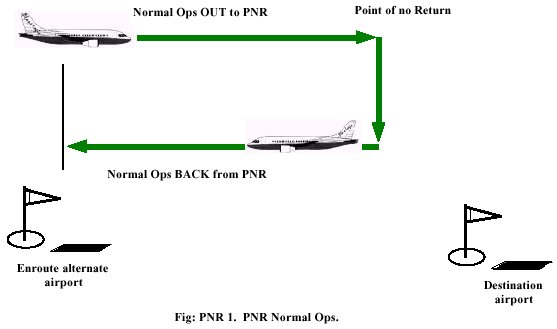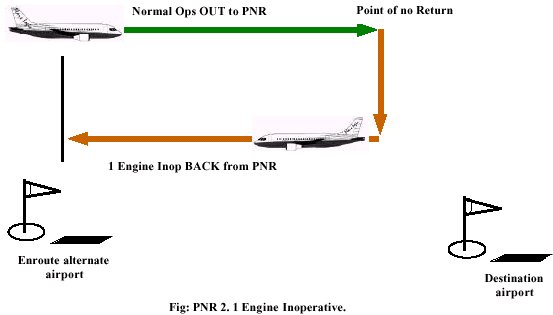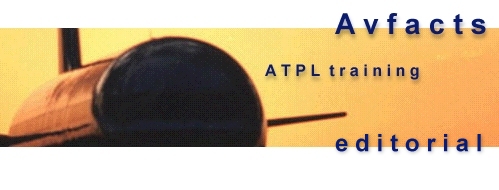The Point of no Return is the
greatest distance that an aircraft can proceed past an airfield, and
return to that airfield with the required reserve fuel still intact
upon landing.
For multi-engined pressurised
aircraft there are three types of PNR.
PNR Normal Ops: This
assumes no loss of cabin pressure, and that the engines continue to
supply
useful power, both out to the PNR
and on the return journey to the airfield. In real life this is the
most
common type of PNR, as modern
turbine engines rarely fail, and cabin depressurisation is
thankfully rare.
An example of a PNR Normal Ops
scenario would be if the pilot was advised enroute that the
destination airfield currently had a disabled aircraft blocking the
runway. The pilot would calculate the last position enroute that
would allow the flight to return to an airfield behind it, the
weather at which was forecast to remain good, and the lighting was
operating satisfactorily.
Nearing the PNR, the pilot would
need to ascertain that the disabled aircraft had been removed from
the runway, and the runway was again fully operational. If it was,
then the flight could continue on to the destination as originally
planned. If the runway had not been cleared by the time the flight
reached the PNR, then the pilot would turn the aircraft around, and
return to the planned alternate. Refer to Fig PNR 1.

1 Engine Inoperative PNR:
This assumes normal operations out to the PNR, but that the aircraft
may suffer
the loss of one of it’s engines
and would in that case return to an airfield behind it. It is
important to remember that you must use the Normal Ops TAS, flight
level and winds out to the PNR, and the
1 Engine Inop TAS, flight level and
winds back from the PNR in this case. As with all simple PNR’s,
you may disregard all descents including descent to the 1 Engine
Inop cruise level and descent into the airport you are returning to.
As aircraft are normally less efficient with one engine shut-down,
this means that, assuming the same reserve fuel is carried for all
operations, the distance to the 1 Engine Inoperative PNR will be
less than the Normal Ops PNR. Refer to Fig’s PNR 2 and 4.

Depressurised PNR: This
assumes normal operations out to the PNR, but that the aircraft
loses the
cabin pressure, and has to return
to the alternate airport behind it at the Depressurised TAS, Flight
Level
(typically FL130) and subject to
the winds and temperatures at that level. Again, you may disregard
all descents when calculating a “SIMPLE PNR”.
Because aircraft (especially jet aircraft) are not at all fuel
efficient at low levels such as
FL130, then assuming the same reserve fuel is carried as for normal
and
1 Engine Inop operations, the
distance to the Depressurised PNR will be the least of these three
scenarios.
Refer to Fig’s PNR 3 and 4.
It should be noted that airline
fuel policy normally states that different reserve fuel is carried
for each of the
three scenarios. This is true in
the Flight Planning portion of the ATPL exam when using either B727
or
B767 aircraft examples. In “SIMPLE
PNR’s the question will quote a “safe endurance” which
will already have the reserve fuel removed. This “safe
endurance” may be regarded as “flight fuel” , all
of which should be burned if you are to fly out to the absolute PNR.










